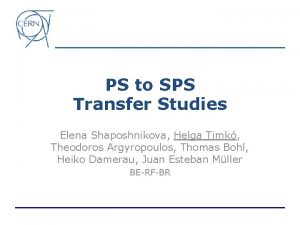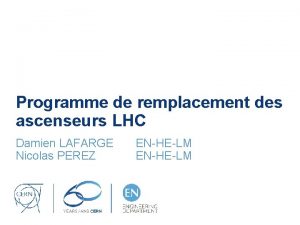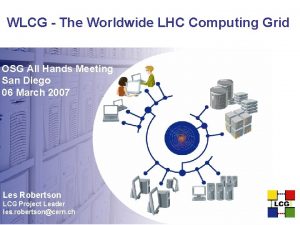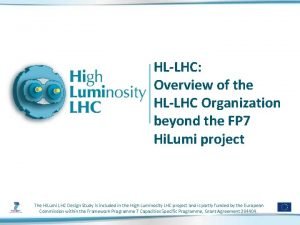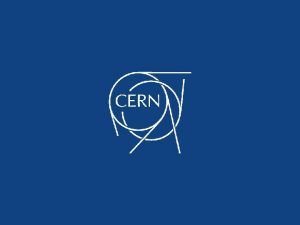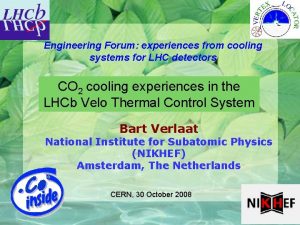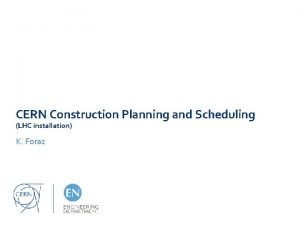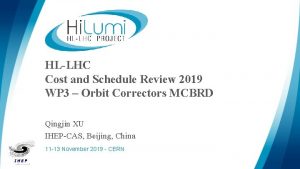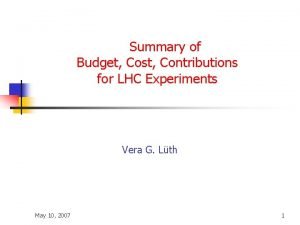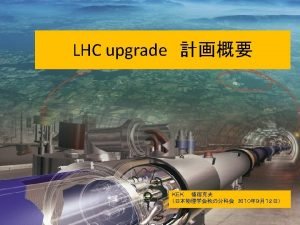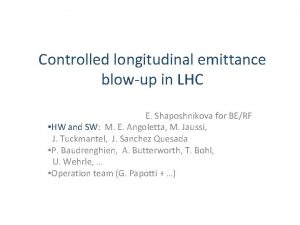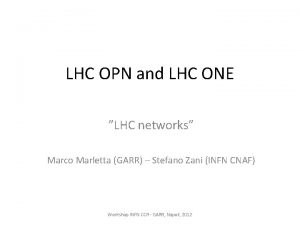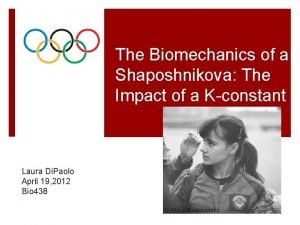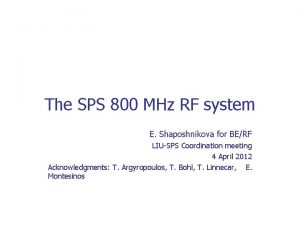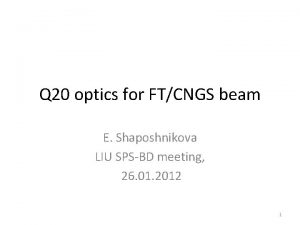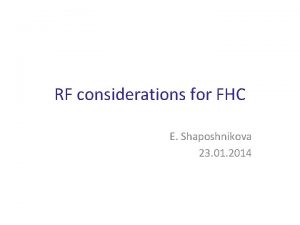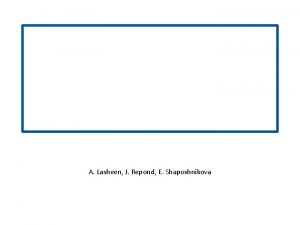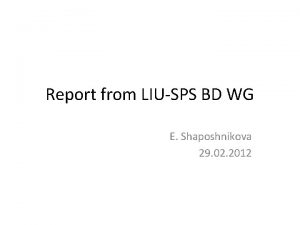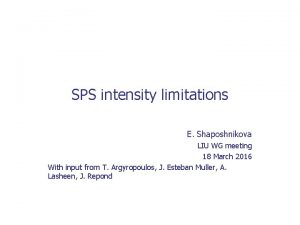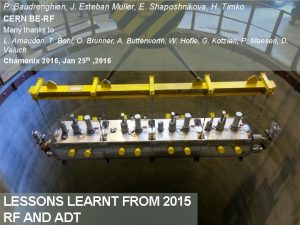RF studies in LHC E Shaposhnikova for the













- Slides: 13

RF studies in LHC E. Shaposhnikova for the RF LHC MD team: T. Argyropoulos, P. Baudrenghien, T. Bohl, J. Esteban Muller, T. Mastoridis (CAL POLY, USA), H. Timko Acknowledgements: A. Butterworth, M. Jaussi, J. Molendijk, G. Papotti, B. Salvant, D. Valuch, U. Wehrle…

Main subjects • Optimisation of the RF and longitudinal beam parameters – – RF voltage program RF set-point bunch length/emittance particle distribution • Longitudinal beam stability – single bunch (loss of Landau damping) – multi- bunch (fundamental RF impedance) • Controlled longitudinal emittance blow-up • Specific beam diagnostics – synchronous phase shift -> e-cloud observation – PD Schottky spectrum -> distribution in synchrotron frequencies • Evaluation of the longitudinal impedance – synchrotron frequency & synchronous phase shift, instability threshold

RF MD Notes from run 1 1. 2. 3. 4. 5. 6. 7. 8. 9. 10. 11. 12. 13. 14. 15. Studies of longitudinal single bunch stability, CERN-ATS-Note-2011 -041 MD Longitudinal single bunch stability in LHC with phase loop on, CERN-ATS-Note-2011 -056 MD Dependence of single beam lifetime on bunch length, CERN-ATS-Note-2011 -083 MD Studies of the LHC impedance at injection energy, CERN-ATS-Note-2012 -060 MD Electron cloud observations through synchronous phase measurements, CERN-ATS-Note-2012 -036 PERF Probing the LHC impedance with single bunches, CERN-ATS-Note-2013 -001 MD Synchronous phase measurements in the LHC for electron cloud observations, CERN-ACC-NOTE 2013 -0007 Beam induced heating reduction by bunch flattening, CERN-ACC-NOTE-2014 -0011 MD Longitudinal oscillations with batch Injection in the LHC, CERN-ATS-Note-2011 -031 MD RF observations during high pile-up MD, CERN-ATS-Note-2012 -099 MD RF observations during high single bunch Intensity MD, CERN-ATS-Note-2012 -023 MD RF observations during 25 ns MD sessions in 2011, CERN-ATS-Note-2012 -024 MD Batch by batch longitudinal emittance blow-up MD, CERN-ATS-Note-2012 -050 MD Cavity voltage phase modulation MD, CERN-ATS-Note-2012 -075 MD Cavity voltage phase modulation MD blocks 3 and 4, CERN-ATS-Note-2013 -013 MD 16. The LHC One-Turn Feedback, CERN-ATS-Note-2012 -025 PERF

RF parameters optimisation • Capture: 6 MV (8 MV in DR) - losses for low and tails for high V • Lower RF voltage is possible during ramp and on the flat top (12 MV → 10 MV in MD and in operation), lumi-leveling (if needed) • RF voltage set-point –> cavity voltage phase modulation is essential for beam intensity above nominal LHC MD#2 2012 : nominal intensity 50 ns beam, cavity phase modulation with 732 bunches Reduction in klystron forward power

Beam parameters optimisation (1/2) • Emittance. Smaller (than in DR) longitudinal emittance is possible on the flat top from longitudinal stability point of view (MDs on beam stability): 1. 0 e. Vs at 4 Te. V and 1. 35 e. Vs at 6. 5 Te. V (tbc) for N=1. 1 x 1011 and V=10 MV • Bunch length. During run 1 bunch length (1. 05 1. 3 ns) was determined by beam induced heating and pile-up issues. Losses for longer bunches in MD. N=1. 15 x 1011 Particle loss rate increases for longer bunches (single bunches, no beam-beam)

Beam parameters optimisation (2/2) • Longitudinal bunch profile • Motivated by issues with beam-induced heating • Flatter bunches obtained by sine-modulation of RF phase at fmod=0. 97 fs, amp =1 deg, T=10 s • Issues with many bunches(excitation at frev + fmod, phase loop on, a=2 deg): bunch length modulation over the whole ring, losses(? ) Bunch length along the ring nominal 50 ns beam (1374 bunches) @ 4 Te. V Flatter bunches – good for heating issues < 1. 2 GHz

Longitudinal single bunch stability Aim: threshold for loss of Landau damping as a function of intensity, beam energy and longitudinal emittance B 1 Results at 4 Te. V with PL off (3 bunches/Beam): Nth ~ 1. 0 x 1011 for ɛ ~ 1. 0 e. Vs (V=12 MV) B 2 Threshold energy & emittance during ramp (PL off) for N= 2. 37 x 1011 Fit: Eth ~ ɛ 2 →controlled BUP: ɛ ~ E 1/2 Run 2 (2015): Nth and ɛth at 6. 5 Te. V and during ramp Higher accuracy (> 3 bunches)

Controlled emittance blow-up using band-limited RF phase noise • In operation – noise is injected through phase loop (PL), but • PL is distorting the noise spectrum • no batch-by-batch BUP possible – feedback on the bunch length (BQM so far): new HW installed for fast and dedicated bunch length • MDs on noise injection through cavity controller loop (CCL): – works for single bunches and with PL on – for few bunches -> variations in final bunch length along the ring (average reaches target bunch length) – not tested with more than a few bunches – New simulation code developed for optimisation -> MD verification • MDs on bunch blow-up/shaping at 6. 5 Te. V (effect of the SR)

RF specific beam diagnostics • Bunch-by-bunch synchronous phase shift (RF phase module) -> e-cloud effect beginning of the scrubbing run (25 ns beam) end of the scrubbing run (25 ns beam) • Peak detected (PD) Shottky spectrum • Particle distribution in synchrotron frequency fs (notches observed on FT due to 50 Hz line or PL ? ) • Measurements of frequency shift with intensity (only for 2 bunches) • LHC BQM: new features • bunch profile (deviation from Gaussian) - e-cloud in 2015 - Operational in the CCC for run 2 - Improvements in phase acquisition (every turn)

Longitudinal impedance evaluation • Synchrotron frequency shift measured at 450 Ge. V (only) using – PD Schottky spectrum: Δf 2 s /N< 1. 0 Hz/1011 –> Im. Z/n < 0. 1Ω – Bunch excitation by phase modulation at given frequency: response when fmod inside fs spectrum: –> Im. Z/n < 0. 1Ω • Synchronous phase shift (for bunches with dif. bunch length & N at 450 Ge. V) • TDI out and in is well visible (5 -10%) • Absolute phase shift is 2 -3 times higher than from the impedance model of N. Mounet • Limitation due to HW (dependence on bunch length and/or intensity) • Some MD time was devoted to calibration

MD requests for run 2 (1/3) • Minimal RF voltage (longitudinal emittance) to maintain Landau damping at 6. 5 Te. V* – Single bunch and multi-bunch case – For nominal and maximum available single bunch intensity • Longitudinal bunch profile (shape and length) evolution during cost without and with collisions (in presence of SR, Tɛ~16 h @6. 5 Te. V)* – BQM measurements, bunch profile acquisition, Schottky specrtum • Studies of controlled RF phase noise* – – Optimised controlled emittance blow-up (using CCL) Batch-by-batch blow-up at injection RF phase modulation for flatter bunches Controlled blow-up during physics (losses) *Studies will start during commissioning but if not finished, will require MD time

MD requests for run 2 (2/3) • Studies of single bunch stability: – Measurements at 6. 5 Te. V. Acceleration with phase loop (PL) on and then PL off. Maximum number of “single” bunches • Fixed intensity, variable longitudinal emittance (in SPS) • Fixed emittance, variable intensity (in SPS) – more difficult due to uncontrolled emittance blow-up in SPS – Measurements during cycle (PL off) • Longitudinal impedance evaluation: – On the flat top – Measure Δfs(N) with very short bunches (shift ~ 1/τ3) • Schottky spectrum • Phase modulation with small fmod steps (<< 0. 1 Hz used in 2012)

MD requests for run 2 (3/3) • Optimal longitudinal parameters in collision – Bunch length, emittance (RF voltage), shape • Cavity voltage phase modulation – Aim: get it operational (to be used for N>Nnom) • Studies of coupled-bunch instabilities due to – fundamental RF cavity impedance – other narrow-band resonant impedances • Longitudinal damper around existing cavities (300 k. Hz) – Should help to damp static injection errors or low mode coupled bunch instabilities (e. g. due to fundamental cavity impedance) – Studies of what can be expected beforehand
